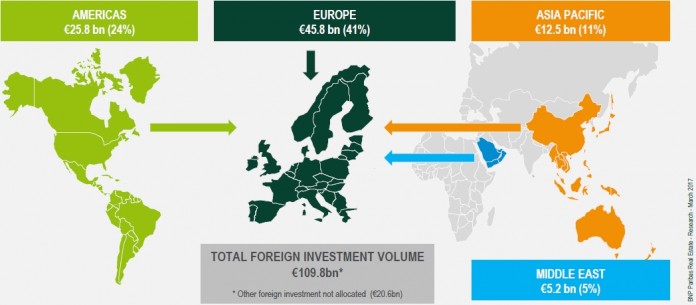The economic recovery continues in the Eurozone. Despite a slowdown at mid-year, GDP maintained a stable pace of growth in 2016 with 1.7% on average. It should enjoy growth close to 1.5 % in 2017, a slight decline on 2016 due to political uncertainties at national level and some less favourable economic fundamentals, such as raw materials, inflation, oil prices and interest rates.
Coming in the wake of a record year 2015, the European investment market, at €230 bn, recorded a 10% slowdown in 2016. The share of cross-border investment also dropped during 2016. Etienne Prongue, head of International Investment Group at BNP Paribas Real Estate, said: “One of the strengths of the European commercial real estate market has been the amount of capital moving in between markets and flowing into Europe. After peaking in 2015, the share of cross-border investment dropped to 48% of the total in 2016 but, at €110 bn, it is still the third highest amount in the last 10 years.”
Amongst foreign investors, Europeans were the most represented (41%) with a volume of € 45.8bn, almost equally split between Eurozone (51%) and non-Eurozone investors (49%).
American investment plunged 37% reaching almost € 26bn in 2016. US investors represented only 24% of total foreign investment volume in Europe (vs. 31% a year ago). Sharp pricing and uncertainties have driven the investors to CEE countries.
Besides a 12% decrease in volume invested into European real estate, the Asian share of cross-border investment total rose to 11%. They became the main foreign investors in the UK, before the Americans.
“Besides drops in volume, there was no change in the relative ranking of the destinations of foreign capital,” said Céline Cotasson-Fauvet head of Pan-European Research at BNP Paribas Real Estate. “Indeed, the UK remained the number one destination for foreign investment in Europe, but dropped 30% in volume due to the wait-and-see attitude of most investors. Germany suffered from an on-going shortage of supply which has held total turnover back, and international investment volume was 20% down on 2015. Whereas, France, albeit dropping 19% of foreign investment, still represent 9% of their European allocations. The main gainers were Ireland, The Netherlands and Central and Eastern Europe.”



















